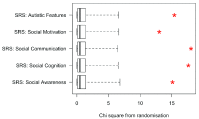Autism and social anxiety in children with sex chromosome trisomies: an observational study
- PMID: 31231689
- PMCID: PMC6567293
- DOI: 10.12688/wellcomeopenres.15095.2
Autism and social anxiety in children with sex chromosome trisomies: an observational study
Abstract
Background: Recent studies suggest that an extra sex chromosome increases the risk of both autism and social anxiety, but it unclear whether these risks are specific to particular karyotypes. Methods: We considered diagnostic data from an online psychiatric assessment (DAWBA - The Development and Well-Being Assessment) and questionnaire responses completed by parents of children with 47,XXX (N = 29), 47,XXY (N = 28) and 47,XYY (N = 32) karyotypes. Analysis focused mainly on 54 children who were diagnosed prenatally or on the basis of other medical concerns in childhood (Low Bias subgroup), to minimise ascertainment bias. Results: Children with symptoms of autism who fell short of meeting the Diagnostic and Statistical Manual of Mental Disorders (DSM)-IV criteria were coded as cases of Pervasive Developmental Disorder Not Otherwise Specified (PDDNOS). The odds ratio of autism or PDDNOS in the Low Bias group was computed relative to gender-specific population norms. This gave log odds ratio (95% confidence interval) of 5.56 (4.25 - 6.88) for XXX girls; 4.00 (2.66 - 5.33) for XXY boys; and 4.60 (3.46 - 5.74) for XYY boys. Despite this elevated risk, most children had no autistic features. A diagnosis of DSM-IV Social Phobia was rare, though, in line with prediction, all three Low Bias cases with this diagnosis had 47,XXY karyotype. All three trisomy groups showed increased risk of milder symptoms of social anxiety. Conclusions: An increased risk of autism was found in girls with 47,XXX karyotype, as well as in boys with 47,XXY or 47,XYY. Symptoms of social anxiety were increased in all three karyotypes. There was wide variation in psychiatric status of children with the same karyotype, suggesting that an extra sex chromosome affects developmental stability in a non-specific way, with a diverse range of possible phenotypes.
Keywords: Autism; DAWBA; Klinefelter syndrome; SRS; XYY syndrome; ascertainment bias; social anxiety; trisomy X.
Conflict of interest statement
No competing interests were disclosed.
Figures




References
-
- Bishop DVM: Language and behavioural phenotypes in children with sex chromosome trisomies.2019. 10.17605/OSF.IO/U2C7D - DOI - PMC - PubMed
Grants and funding
LinkOut - more resources
Full Text Sources

